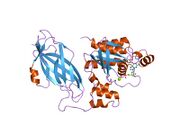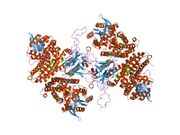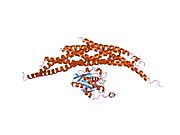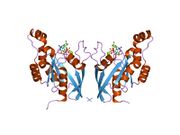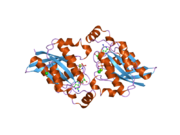Biology:RAC1
 Generic protein structure example |
Rac1, also known as Ras-related C3 botulinum toxin substrate 1, is a protein found in human cells. It is encoded by the RAC1 gene.[1][2] This gene can produce a variety of alternatively spliced versions of the Rac1 protein, which appear to carry out different functions.[3]
Function
Rac1 is a small (~21 kDa) signaling G protein (more specifically a GTPase), and is a member of the Rac subfamily of the family Rho family of GTPases. Members of this superfamily appear to regulate a diverse array of cellular events, including the control of GLUT4[4][5] translocation to glucose uptake, cell growth, cytoskeletal reorganization, antimicrobial cytotoxicity,[6] and the activation of protein kinases.[7]
Rac1 is a pleiotropic regulator of many cellular processes, including the cell cycle, cell-cell adhesion, motility (through the actin network), and of epithelial differentiation (proposed to be necessary for maintaining epidermal stem cells).
Role in cancer
Along with other subfamily of Rac and Rho proteins, they exert an important regulatory role specifically in cell motility and cell growth. Rac1 has ubiquitous tissue expression, and drives cell motility by formation of lamellipodia.[8] In order for cancer cells to grow and invade local and distant tissues, deregulation of cell motility is one of the hallmark events in cancer cell invasion and metastasis.[9] Overexpression of a constitutively active Rac1 V12 in mice caused a tumor that's phenotypically indistinguishable from human Kaposi's sarcoma.[10] Activating or gain-of-function mutations of Rac1 are shown to play active roles in promoting mesenchymal-type of cell movement assisted by NEDD9 and DOCK3 protein complex.[11] Such abnormal cell motility may result in epithelial mesenchymal transition (EMT) – a driving mechanism for tumor metastasis as well as drug-resistant tumor relapse.[12][13]
Role in glucose transport
Rac1 is expressed in significant amounts in insulin sensitive tissues, such as adipose tissue and skeletal muscle. Here Rac1 regulated the translocation of glucose transporting GLUT4 vesicles from intracellular compartments to the plasma membrane.[5][14][15] In response to insulin, this allows for blood glucose to enter the cell to lower blood glucose. In conditions of obesity and type 2 diabetes, Rac1 signaling in skeletal muscle is dysfunctional, suggesting that Rac1 contributes to the progression of the disease. Rac1 protein is also necessary for glucose uptake in skeletal muscle activated by exercise[4][16] and muscle stretching[17]
Clinical significance
Activating mutations in Rac1 have been recently discovered in large-scale genomic studies involving melanoma[18][19][20] and non-small cell lung cancer.[21] As a result, Rac1 is considered a therapeutic target for many of these diseases.[22]
A few recent studies have also exploited targeted therapy to suppress tumor growth by pharmacological inhibition of Rac1 activity in metastatic melanoma and liver cancer as well as in human breast cancer.[23][24][25] For example, Rac1-dependent pathway inhibition resulted in the reversal of tumor cell phenotypes, suggesting Rac1 as a predictive marker and therapeutic target for trastuzumab-resistant breast cancer.[24] However, given Rac1's role in glucose transport, drugs that inhibits Rac1 could potentially be harmful to glucose homeostasis.
Dominant negative or constitutively active germline RAC1 mutations cause diverse phenotypes that have been grouped together as Mental Retardation Type 48.[26] Most mutations cause microcephaly while some specific changes appear to result in macrocephaly.
Interactions
RAC1 has been shown to interact with:
- ARFIP2,[27][28][29]
- ARHGDIA,[30][31][32][33][34][35]
- BAIAP2,[36]
- FHOD1,[37]
- FMNL1,[38]
- IQGAP1,[39][40][41][42]
- IQGAP2,[43]
- Myd88,[44]
- DMPK,[45]
- NCKAP1,[46]
- PAK1,[39][47][48]
- PAK3,[27]
- PARD6A,[49][50]
- PARD6B,[49]
- RICS[51][52]
- STAT3,[53] and
- TIAM1.[54][55]
References
- ↑ "rac, a novel ras-related family of proteins that are botulinum toxin substrates". The Journal of Biological Chemistry 264 (28): 16378–82. Oct 1989. doi:10.1016/S0021-9258(19)84716-6. PMID 2674130.
- ↑ "Cloning of a novel human Rac1b splice variant with increased expression in colorectal tumors". Oncogene 18 (48): 6835–9. Nov 1999. doi:10.1038/sj.onc.1203233. PMID 10597294.
- ↑ "The Rac1 splice form Rac1b promotes K-ras-induced lung tumorigenesis". Oncogene 32 (7): 903–9. Feb 2013. doi:10.1038/onc.2012.99. PMID 22430205.
- ↑ 4.0 4.1 Sylow, Lykke; Nielsen, Ida L.; Kleinert, Maximilian; Møller, Lisbeth L. V.; Ploug, Thorkil; Schjerling, Peter; Bilan, Philip J.; Klip, Amira et al. (2016-04-09). "Rac1 governs exercise-stimulated glucose uptake in skeletal muscle through regulation of GLUT4 translocation in mice". The Journal of Physiology 594 (17): 4997–5008. doi:10.1113/JP272039. ISSN 1469-7793. PMID 27061726.
- ↑ 5.0 5.1 "Crucial role of the small GTPase Rac1 in insulin-stimulated translocation of glucose transporter 4 to the mouse skeletal muscle sarcolemma". FASEB Journal 24 (7): 2254–61. Jul 2010. doi:10.1096/fj.09-137380. PMID 20203090.
- ↑ "Ras-related C3 Botulinum Toxin Substrate (Rac) and Src Family Kinases (SFK) Are Proximal and Essential for Phosphatidylinositol 3-Kinase (PI3K) Activation in Natural Killer (NK) Cell-mediated Direct Cytotoxicity against Cryptococcus neoformans". J Biol Chem 291 (13): 6912–22. Mar 2016. doi:10.1074/jbc.M115.681544. PMID 26867574.
- ↑ "Rho GTPases and actin dynamics in membrane protrusions and vesicle trafficking". Trends in Cell Biology 16 (10): 522–9. Oct 2006. doi:10.1016/j.tcb.2006.08.006. PMID 16949823.
- ↑ "Rac and Rho GTPases in cancer cell motility control". Cell Communication and Signaling 8 (23): 23. 2010. doi:10.1186/1478-811x-8-23. PMID 20822528.
- ↑ "Hallmarks of cancer: the next generation". Cell 144 (5): 646–74. Mar 2011. doi:10.1016/j.cell.2011.02.013. PMID 21376230.
- ↑ Ma, Qi; Cavallin, Lucas E.; Yan, Bin; Zhu, Shoukang; Duran, Elda Margarita; Wang, Huili; Hale, Laura P.; Dong, Chunming et al. (2009-05-26). "Antitumorigenesis of antioxidants in a transgenic Rac1 model of Kaposi's sarcoma" (in en). Proceedings of the National Academy of Sciences 106 (21): 8683–8688. doi:10.1073/pnas.0812688106. ISSN 0027-8424. PMID 19429708. Bibcode: 2009PNAS..106.8683M.
- ↑ "Rac activation and inactivation control plasticity of tumor cell movement". Cell 135 (3): 510–23. Oct 2008. doi:10.1016/j.cell.2008.09.043. PMID 18984162.
- ↑ "Matrix metalloproteinase induction of Rac1b, a key effector of lung cancer progression". Science Translational Medicine 4 (142): 510–523. Jul 11, 2012. doi:10.1126/scitranslmed.3004062. PMID 22786680.
- ↑ "RAC1 activation mediates Twist1-induced cancer cell migration". Nature Cell Biology 14 (4): 366–74. Apr 2012. doi:10.1038/ncb2455. PMID 22407364.
- ↑ "Akt and Rac1 signaling are jointly required for insulin-stimulated glucose uptake in skeletal muscle and downregulated in insulin resistance". Cellular Signalling 26 (2): 323–31. Feb 2014. doi:10.1016/j.cellsig.2013.11.007. PMID 24216610.
- ↑ "Rac1 signaling is required for insulin-stimulated glucose uptake and is dysregulated in insulin-resistant murine and human skeletal muscle". Diabetes 62 (6): 1865–75. Jun 2013. doi:10.2337/db12-1148. PMID 23423567.
- ↑ "Rac1 is a novel regulator of contraction-stimulated glucose uptake in skeletal muscle". Diabetes 62 (4): 1139–51. Apr 2013. doi:10.2337/db12-0491. PMID 23274900.
- ↑ "Stretch-stimulated glucose transport in skeletal muscle is regulated by Rac1". The Journal of Physiology 593 (3): 645–56. Feb 2015. doi:10.1113/jphysiol.2014.284281. PMID 25416624.
- ↑ "A landscape of driver mutations in melanoma". Cell 150 (2): 251–63. Jul 2012. doi:10.1016/j.cell.2012.06.024. PMID 22817889.
- ↑ "Exome sequencing identifies recurrent somatic RAC1 mutations in melanoma". Nature Genetics 44 (9): 1006–14. Sep 2012. doi:10.1038/ng.2359. PMID 22842228.
- ↑ "Rac1 activity regulates proliferation of aggressive metastatic melanoma". Experimental Cell Research 313 (18): 3832–9. Nov 2007. doi:10.1016/j.yexcr.2007.08.017. PMID 17904119.
- ↑ "Matrix metalloproteinase induction of Rac1b, a key effector of lung cancer progression". Science Translational Medicine 4 (142): 142ra95. Jul 2012. doi:10.1126/scitranslmed.3004062. PMID 22786680.
- ↑ "Got a light? Illuminating lung cancer". Science Translational Medicine 4 (142): 142fs22. Jul 2012. doi:10.1126/scitranslmed.3004446. PMID 22786678.
- ↑ "Silencing of Rac1 modifies lung cancer cell migration, invasion and actin cytoskeleton rearrangements and enhances chemosensitivity to antitumor drugs". International Journal of Molecular Medicine 28 (5): 769–776. Nov 2011. doi:10.3892/ijmm.2011.775. PMID 21837360.
- ↑ 24.0 24.1 "Rac1 contributes to trastuzumab resistance of breast cancer cells: Rac1 as a potential therapeutic target for the treatment of trastuzumab-resistant breast cancer". Molecular Cancer Therapeutics 8 (6): 1557–69. Jun 2009. doi:10.1158/1535-7163.mct-09-0140. PMID 19509242.
- ↑ "Melittin prevents liver cancer cell metastasis through inhibition of the Rac1-dependent pathway". Hepatology 47 (6): 1964–73. Jun 2008. doi:10.1002/hep.22240. PMID 18506888.
- ↑ Reijnders, Margot R.F.; Ansor, Nurhuda M.; Kousi, Maria; Yue, Wyatt W.; Tan, Perciliz L.; Clarkson, Katie; Clayton-Smith, Jill; Corning, Ken et al. (September 2017). "RAC1 Missense Mutations in Developmental Disorders with Diverse Phenotypes". The American Journal of Human Genetics 101 (3): 466–477. doi:10.1016/j.ajhg.2017.08.007. PMID 28886345.
- ↑ 27.0 27.1 "Differential binding of arfaptin 2/POR1 to ADP-ribosylation factors and Rac1". Biochemical and Biophysical Research Communications 285 (5): 1267–73. Aug 2001. doi:10.1006/bbrc.2001.5330. PMID 11478794.
- ↑ "Identification of a novel Rac1-interacting protein involved in membrane ruffling". The EMBO Journal 15 (15): 3778–86. Aug 1996. doi:10.1002/j.1460-2075.1996.tb00751.x. PMID 8670882.
- ↑ "The structural basis of Arfaptin-mediated cross-talk between Rac and Arf signalling pathways". Nature 411 (6834): 215–9. May 2001. doi:10.1038/35075620. PMID 11346801.
- ↑ "Large-scale mapping of human protein-protein interactions by mass spectrometry". Molecular Systems Biology 3 (1): 89. 2007. doi:10.1038/msb4100134. PMID 17353931.
- ↑ "Crystal structure of the Rac1-RhoGDI complex involved in nadph oxidase activation". Biochemistry 40 (34): 10007–13. Aug 2001. doi:10.1021/bi010288k. PMID 11513578.
- ↑ "Mapping the binding site for the GTP-binding protein Rac-1 on its inhibitor RhoGDI-1". Structure 8 (1): 47–55. Jan 2000. doi:10.1016/S0969-2126(00)00080-0. PMID 10673424.
- ↑ "Differential properties of D4/LyGDI versus RhoGDI: phosphorylation and rho GTPase selectivity". FEBS Letters 422 (2): 269–73. Jan 1998. doi:10.1016/S0014-5793(98)00020-9. PMID 9490022.
- ↑ "Mechanism of NADPH oxidase activation by the Rac/Rho-GDI complex". Biochemistry 40 (34): 10014–22. Aug 2001. doi:10.1021/bi010289c. PMID 11513579.
- ↑ "Interactions between Rho GTPases and Rho GDP dissociation inhibitor (Rho-GDI)". Biochimie 83 (5): 409–14. May 2001. doi:10.1016/S0300-9084(01)01263-9. PMID 11368848.
- ↑ "IRSp53 is an essential intermediate between Rac and WAVE in the regulation of membrane ruffling". Nature 408 (6813): 732–5. Dec 2000. doi:10.1038/35047107. PMID 11130076. Bibcode: 2000Natur.408..732M.
- ↑ "The formin/diaphanous-related protein, FHOS, interacts with Rac1 and activates transcription from the serum response element". The Journal of Biological Chemistry 276 (49): 46453–9. Dec 2001. doi:10.1074/jbc.M105162200. PMID 11590143.
- ↑ "FRL, a novel formin-related protein, binds to Rac and regulates cell motility and survival of macrophages". Molecular and Cellular Biology 20 (18): 6872–81. Sep 2000. doi:10.1128/MCB.20.18.6872-6881.2000. PMID 10958683.
- ↑ 39.0 39.1 "Interaction of Rac1 with GTPase-activating proteins and putative effectors. A comparison with Cdc42 and RhoA". The Journal of Biological Chemistry 273 (15): 8776–82. Apr 1998. doi:10.1074/jbc.273.15.8776. PMID 9535855.
- ↑ "Identification of IQGAP as a putative target for the small GTPases, Cdc42 and Rac1". The Journal of Biological Chemistry 271 (38): 23363–7. Sep 1996. doi:10.1074/jbc.271.38.23363. PMID 8798539.
- ↑ "Rac1 and Cdc42 capture microtubules through IQGAP1 and CLIP-170". Cell 109 (7): 873–85. Jun 2002. doi:10.1016/S0092-8674(02)00800-0. PMID 12110184.
- ↑ "IQGAP1, a calmodulin-binding protein with a rasGAP-related domain, is a potential effector for cdc42Hs". The EMBO Journal 15 (12): 2997–3005. Jun 1996. doi:10.1002/j.1460-2075.1996.tb00663.x. PMID 8670801.
- ↑ "The Ras GTPase-activating-protein-related human protein IQGAP2 harbors a potential actin binding domain and interacts with calmodulin and Rho family GTPases". Molecular and Cellular Biology 16 (9): 4869–78. Sep 1996. doi:10.1128/mcb.16.9.4869. PMID 8756646.
- ↑ "Transactivation by the p65 subunit of NF-kappaB in response to interleukin-1 (IL-1) involves MyD88, IL-1 receptor-associated kinase 1, TRAF-6, and Rac1". Molecular and Cellular Biology 21 (14): 4544–52. Jul 2001. doi:10.1128/MCB.21.14.4544-4552.2001. PMID 11416133. PMC 87113. http://www.tara.tcd.ie/bitstream/2262/33698/1/Transactivation%20by%20the%20p65%20subunit%20of%20NF-kappaB%20in%20response%20to%20interleukin-1%20%28IL-1%29%20involves%20MyD88%2c%20IL-1%20receptor-associated%20kinase%201%2c%20TRAF-6%2c%20and%20Rac1.pdf.
- ↑ "Rac-1 and Raf-1 kinases, components of distinct signaling pathways, activate myotonic dystrophy protein kinase". FEBS Letters 475 (3): 273–7. Jun 2000. doi:10.1016/S0014-5793(00)01692-6. PMID 10869570.
- ↑ "Interaction of Nck-associated protein 1 with activated GTP-binding protein Rac". The Biochemical Journal 322 (3): 873–8. Mar 1997. doi:10.1042/bj3220873. PMID 9148763.
- ↑ "RhoG activates Rac1 by direct interaction with the Dock180-binding protein Elmo". Nature 424 (6947): 461–4. Jul 2003. doi:10.1038/nature01817. PMID 12879077. Bibcode: 2003Natur.424..461K.
- ↑ "ArhGAP15, a novel human RacGAP protein with GTPase binding property". FEBS Letters 539 (1–3): 131–7. Mar 2003. doi:10.1016/S0014-5793(03)00213-8. PMID 12650940.
- ↑ 49.0 49.1 "Human homologues of the Caenorhabditis elegans cell polarity protein PAR6 as an adaptor that links the small GTPases Rac and Cdc42 to atypical protein kinase C". Genes to Cells 6 (2): 107–19. Feb 2001. doi:10.1046/j.1365-2443.2001.00404.x. PMID 11260256.
- ↑ "A human homolog of the C. elegans polarity determinant Par-6 links Rac and Cdc42 to PKCzeta signaling and cell transformation". Current Biology 10 (12): 697–707. Jun 2000. doi:10.1016/S0960-9822(00)00535-2. PMID 10873802.
- ↑ "GC-GAP, a Rho family GTPase-activating protein that interacts with signaling adapters Gab1 and Gab2". The Journal of Biological Chemistry 278 (36): 34641–53. Sep 2003. doi:10.1074/jbc.M304594200. PMID 12819203.
- ↑ "Characterization of a brain-specific Rho GTPase-activating protein, p200RhoGAP". The Journal of Biological Chemistry 278 (6): 4151–9. Feb 2003. doi:10.1074/jbc.M207789200. PMID 12454018.
- ↑ "Regulation of STAT3 by direct binding to the Rac1 GTPase". Science 290 (5489): 144–7. Oct 2000. doi:10.1126/science.290.5489.144. PMID 11021801. Bibcode: 2000Sci...290..144S.
- ↑ "Crystal structure of Rac1 in complex with the guanine nucleotide exchange region of Tiam1". Nature 408 (6813): 682–8. Dec 2000. doi:10.1038/35047014. PMID 11130063. Bibcode: 2000Natur.408..682W.
- ↑ "Trp(56) of rac1 specifies interaction with a subset of guanine nucleotide exchange factors". The Journal of Biological Chemistry 276 (50): 47530–41. Dec 2001. doi:10.1074/jbc.M108865200. PMID 11595749.
Further reading
- "Stem cell depletion through epidermal deletion of Rac1". Science 309 (5736): 933–5. Aug 2005. doi:10.1126/science.1113579. PMID 16081735. Bibcode: 2005Sci...309..933A.
- "Rho proteins, mental retardation and the cellular basis of cognition". Trends in Neurosciences 25 (4): 191–9. Apr 2002. doi:10.1016/S0166-2236(00)02118-4. PMID 11998687.
- "Suppression of nuclear Wnt signaling leads to stabilization of Rac1 isoforms". FEBS Letters 581 (25): 4850–6. Oct 2007. doi:10.1016/j.febslet.2007.09.013. PMID 17888911.
External links
- rac1+GTP-Binding+Protein at the US National Library of Medicine Medical Subject Headings (MeSH)
- RAC1 Info with links in the Cell Migration Gateway
